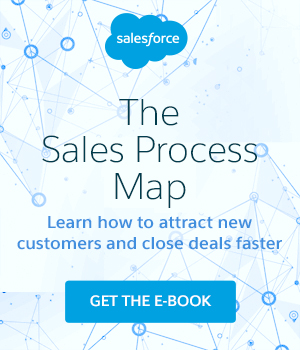
Get your FREE 30-day trial.
Please complete all fields.
To grow a business and operate more efficiently than the competition, you need a well-defined sales process. Each new employee should understand where leads come from, how they’re followed up with, and what steps need to take place to close a deal. Getting alignment on these basic principles will help you train reps faster, improve data quality, and provide a more consistent customer experience.
A good way to get started, is by creating a sales process map. To make it easy for you, we created the map below which you can use as a starting point.
 The map will walk you through the three stages:
The map will walk you through the three stages:
It is available as a powerpoint file so you can edit it with terminology that is familiar to your employees and maps to the application you’re using.
How to create your own sales process map
1. Meet with your executives and the project team who oversees your CRM implementation to get alignment on the big picture. What information do you need to track, what are the rules of engagement, where are the hand-offs, and what should you be measuring? These conversations will help you customize your CRM application and design the dashboards you need to stay on top of your business.
2. Documenting your sales process is also an important building block for any training program. Once you’ve got your process map locked down, print it out and have new employees pin it up in their cube. Take 15 minutes to meet with them to talk through each stage of the process so they have a firm understanding of how you run your business and what success metrics you want to hold them accountable for.
3. Having a clear vision of what metrics you want to track and why they’re important helps employees understand the value of data quality. As they say, you can’t measure what you can’t track. By talking about each metric, employees start to see how their role impacts others downstream and they start to think about what levers they can pull to drive more revenue.
For example, what are your top sources of leads and how is that changing over time? And what percentage of your leads are being deaded out and why? This could be an early indicator of sales success and something you want to track closely. If you can pull up a live dashboard to have these conversations and use real-world examples, even better.
4. Start thinking outside the box and factor in social media into your sales process. Now while the process map includes all the traditional leads sources you’d expect, we’ve also updated it for social media. In a recent survey by IBM, they found that companies expect social media to become the second most important customer touchpoint in 3-5 years. It’ll be a bigger touchpoint than the website is today, and second only to face-to-face interaction. Given that, companies need to start thinking about how they manage and measure the interactions beyond their website and how they use social to drive incremental leads.
The video below gives you a sense for how companies are using marketing automation to measure the value of social and it highlights the 6 plays that we’re adding to every campaign to drive incremental pipeline.
So that’s quick introduction to the Sales Process Map. Tell us;
Learn more about a strong sales process with the free e-book below.